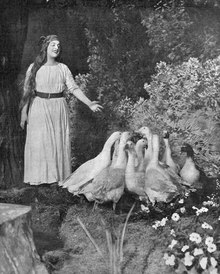Königskinder
Template:Humperdinck operas Königskinder (German for The King's Children) is a stage work by Engelbert Humperdinck that exists in two versions: as a melodrama and as an opera or more precisely a Märchenoper. The libretto was written by Ernst Rosmer (pen name of Else Bernstein-Porges), adapted from her play of the same name.
In 1894, Heinrich Porges asked Humperdinck to write incidental music for his daughter Else's play. Humperdinck was interested in making the story into an opera but since Else Bernstein-Porges initially refused, he opted for the play to be staged as a melodrama – that is with spoken dialog taking place along with an instrumental backdrop. (The work also included operatic arias and choruses, as well as unaccompanied dialog.)
In the melodramatic passages, Humperdinck designed an innovative hybrid notation that called for a text delivery somewhere between singing and speech. With this notation, the singer was expected to deliver a substantial portion of the text with approximate pitched melodies. This version was first staged at the Munich Hoftheater, with Hedwig Schako as the goose girl, on 23 January 1897 and enjoyed some success. However, Else Bernstein-Porges finally relented in 1907 and agreed that Humperdinck could transform the work into an opera.
Performance history
Königskinder was first performed at the Metropolitan Opera in New York on 28 December 1910, conducted by Alfred Hertz, with Geraldine Farrar as the Goose-Girl, Herman Jadlowker as the King's Son, Louise Homer as the Witch and Otto Goritz as the Fiddler. Farrar trained her own flock of geese in preparation for the role; according to a New-York Tribune review of the first performance, "Miss Farrar caused 'much amusement' by appearing before the curtain with a live goose under her arm."[1]
A Berlin premiere followed on 14 January 1911, conducted by Leo Blech with Lola Artôt de Padilla as the Goose-Girl and Walter Kirchhoff as the King's Son. Though the work lay in the shadow of its "sister" fairy-tale work Hänsel und Gretel for many years, it has been regularly revived in Germany, and with increasing frequency abroad since 1986 (Wexford Festival). Other notable productions include the 1992 English National Opera, directed by David Pountney and conducted by Sir Mark Elder; a 1997 staging at Sarasota Opera; from 2005 to 2007 at the Bavarian State Opera; and in 2007 at the Zurich Opera House. In 2010, dell'Arte Opera Ensemble gave a performance celebrating the hundredth anniversary of its premiere in New York City. It has also been frequently recorded.
Roles

| Role | Voice type | Premiere cast, 28 December 1910 (Conductor: Alfred Hertz) |
|---|---|---|
| Goose-Girl (Gänsemagd) | soprano | Geraldine Farrar |
| Witch (Hexe) | contralto | Louise Homer |
| King's son (Köningssohn) | tenor | Herman Jadlowker |
| Fiddler (Spielmann) | baritone | Otto Goritz |
| Woodcutter | bass | Adamo Didur |
| Broom-maker | tenor | Albert Reiss |
| Stable girl | contralto | Marie Mattfeld |
| Innkeeper's daughter | mezzo-soprano | Florence Wickham |
| First gatekeeper | tenor | Ernst Maran |
| Second gatekeeper | baritone | William Hinshaw |
| Innkeeper | bass | Antonio Pini-Corsi |
| First child | soprano | Edna Walter |
| Second child | soprano | Lotte Engel |
| Senior councillor | baritone | Marcel Reiner |
| Tailor | tenor | Julius Bayer |
Recordings
- 1952: Käthe Möller-Siepermann (Goose-Girl), Ilsa Ihme-Säbisch (Witch), Peter Anders (King's Son), Dietrich Fischer-Dieskau (Fiddler), WDR Symphony Orchestra Cologne, conducted by Richard Kraus, live in Cologne, Walhall
- 1976: Helen Donath / Hanna Schwarz / Adolf Dallapozza / Hermann Prey, Münchner Rundfunkorchester, conducted by Heinz Wallberg, EMI (released on CD in 1989)
- 1996: Dagmar Schellenberger / Marilyn Schmiege / Thomas Moser / Dietrich Henschel, Münchner Rundfunkorchester, conducted by Fabio Luisi, Calig
- 2005: Ofelia Sala / Nora Gubisch / Jonas Kaufmann / Detlef Roth, Orchestre national de Montpellier Languedoc-Roussillon, conducted by Armin Jordan, live in Montpellier, Accord
- 2007: Isabel Rey / Liliana Nikiteanu / Jonas Kaufmann / Oliver Widmer, Opernhaus Zürich, conducted by Ingo Metzmacher, videorecording from Zurich, Encore
- 2008: Juliane Banse / Gabriele Schnaut / Klaus Florian Vogt / Christian Gerhaher, Deutsches Symphonie-Orchester Berlin, conducted by Ingo Metzmacher, live in Berlin, Premiere Opera (also released Crystal Classics : Deutschlandradio Kultur, 2011)
References
Notes
- ^ Metropolitan Opera Archives, world premiere in the presence of the composer, review from the New-York Tribune by Henry Krehbiel. "Königskinder, Metropolitan Opera House: December 28, 1910".. Met performance CID 49510. Accessed 31 March 2013.
Sources
- Glauert, Amanda (1992). "Königskinder" in The New Grove Dictionary of Opera, 4 vols., edited by Stanley Sadie. London: Macmillan Publishers. ISBN 0-333-73432-7
- Operadis discography, accessed 11 November 2010
External links
- Königskinder: Scores at the International Music Score Library Project
- Oldandsold.com synopsis and original cast
- "A new production by dell'Arte Opera Ensemble". Retrieved 17 November 2010.
